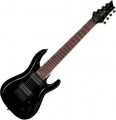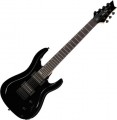Number of strings
The number of strings provided in the design of the guitar. The meaning of this parameter depends on the type of instrument (see above).
The most common by far is the Spanish (
six-string) tuning; accordingly, most electric guitars and semi-acoustic instruments have exactly 6 strings. A smaller number is practically never found, but a larger one may well be used — models are produced for
7 and even 8 strings. Usually, they belong to the class of so-called baritone guitar, which is a transitional option between a conventional electric guitar and bass. The main 6 strings in "baritones" are tuned slightly lower than usual, and in addition to them, one or two more bass strings are installed. In combination with the increased length of the scale, this allows to achieve a richer and denser sound; it is especially appreciated by performers of heavy styles of music like death metal, although it can also be used in less "extreme" genres.
As for bass guitars, they have a standard number of strings —
4, and "extended" models have
5, occasionally —
6 strings. At the same time, unlike guitars, additional strings in basses are designed not to lower, but to increase the range. Using additional "raised" strings is often much more convenient than clamping the high frets.
Nut width
The width of the fretboard of an electric guitar at the nut. Closer to the body, the neck may expand somewhat, but this is not necessary, and the expansion angle may be different. Therefore, the main size is considered to be the width in the region of the nut.
This parameter has two meanings. On the one hand, a wide neck is inconvenient for musicians with small hands and short fingers — it can be difficult to reach the far strings in such cases. On the other hand, a larger width means a greater distance between the individual strings, which reduces the likelihood of hitting an adjacent string when pressed incorrectly and can make playing easier (especially if the guitarist has large fat fingers). However, these moments are not absolute, and the convenience of playing is a very subjective matter, depending on many features of the musician and the technique he uses. Also, don't forget that necks can have different profiles (see above), and instruments with different neck profiles will feel differently in the hands even with the same width at the nut. Therefore, the most reliable method of selection is to try out the necks of different sizes and profiles “live”, decide on the best option and choose based on this.
The smallest neck width at the nut in modern electric guitars is about 39 mm. This size is found mainly in bass guitars (see “Type”), which have 4 strings and a neck that widens noticeably towards the body (due to which it can be made rather narr...ow from above, especially since when playing bass, notes are rarely clamped near the neck itself) . Electric guitars (including semi-acoustic) are somewhat wider — from 41 mm, an indicator of 43 – 48 mm is considered average, and in the largest instruments, the neck can be up to 55 mm wide (however, such dimensions are typical mainly for instruments with more than 6 strings) .
Fretboard radius
The radius of curvature of a fretboard mounted on the fretboard of an electric guitar.
The fingerboard is located directly under the strings, it is to it that the musician presses the strings when playing. If you look at the neck in cross section, its upper part with the overlay will have the shape of an arc; the radius of this arc is implied in this case. The smaller the radius, the more convex this arc will be, and vice versa, a large radius will correspond to an almost flat surface.
In general, it is believed that a smaller fingerboard radius is better for playing chords, and a more even, flat surface makes it easier to play technical passages with an abundance of special techniques such as bands. The average and, one might say, classic diameter value is 12", this is the most popular option among modern electric guitars. The smallest figure is just over 7", it is found in some guitars with Stratocaster bodies (both original Fender instruments and copies ). And the most flat pads have a diameter of 20" or more.
Note that there are often instruments with a variable fretboard radius — smaller at the headstock (where chords are played more often) and larger near the body (where solos are played by notes). In such cases, the radius at the nut is indicated.
Scale
The scale is the distance from the nut to the bridge; in other words, this is the working length of the open (not pressed with a finger) string. The greater this distance, the more tightly the strings must be stretched to achieve the desired pitch and the greater the force required to press them against the fingerboard. However, some guitarists argue that even a small difference in length - less than an inch - already makes a significant difference in the feel when playing.
In addition, this parameter also affects the color of the sound. A longer length allows you to get a brighter, louder and more expressive sound, while a shorter length allows you to get a denser, “warmer” and smoother sound. Thus, all other things being equal, a relatively short scale length is better for playing chords, while a longer instrument may be needed to achieve the desired sound in a solo.
The most popular scale length options in electric guitars (not basses) are
24.75" (Gibson) and
25.5" (Fender). Indicators less than 22" are extremely rare, mainly in instruments with miniature 3/4" bodies (see "Size"), and the maximum value is about 28", longer instruments are practically not produced. But basses have a noticeably longer length ( otherwise the strings for them would have to be made too thick or tensioned too loosely): the shortest models provide a scale length of 30", but the classic value is
34".
Note that the design of the bridge often allows you to change the actual scale length (including for each string separately); This is done to ensure that the instrument plays accurately along the frets. Therefore, in the characteristics it is customary to indicate the default scale length, without additional adjustments.

